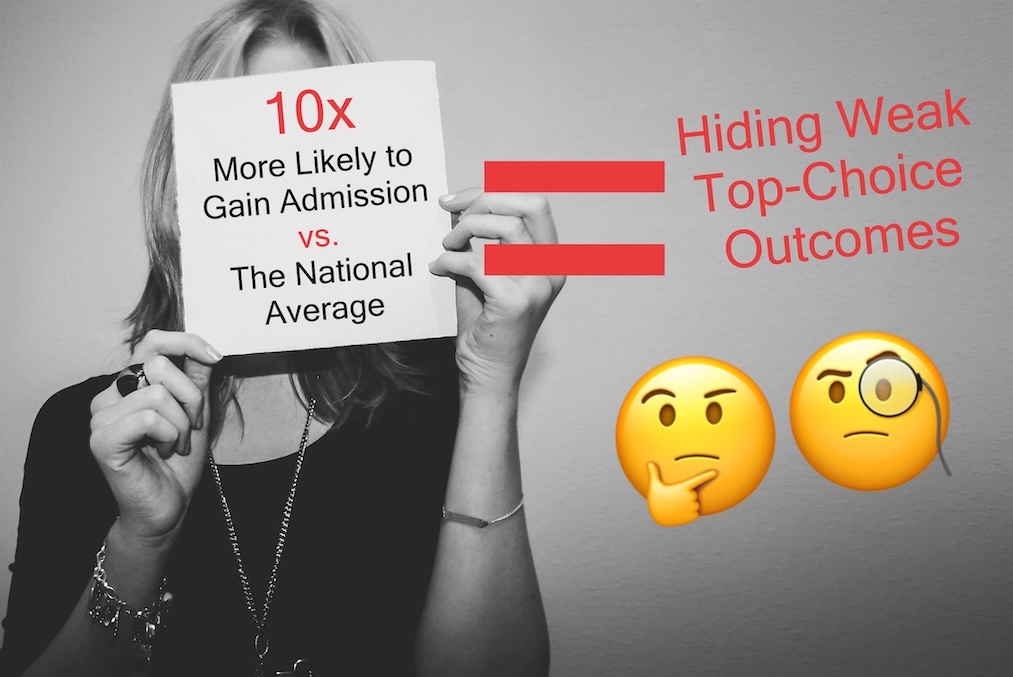College Consultant Success Rates Exposed: Were You Fooled?
- By College Zoom
- In Consumer Alerts

Preview:
Admissions advantage multipliers are the most misleading success rates in the college admissions consulting industry. Interestingly, the firms that cite the highest admit rate multipliers often have the weakest top-choice college outcomes. Advantage multiplier statistics are most embraced by marketplace-style college consulting firms that prioritize client volume over personalized, high-quality, and results-oriented service. You wouldn’t know it from their marketing, which makes them look hyper-focused on results. Here's why.
The Most Misleading Success Metric in College Admissions Consulting
Admissions Advantage Multipliers
Admissions advantage multipliers—claims that a firm’s clients are X times more likely to be admitted than the average applicant—have become one of the most widespread success metrics in college consulting. The multipliers sound very impressive. So why do the firms who claim the highest multipliers tend to also have the lowest top-choice outcomes?
Let’s unpack how this metric works.
1. Multipliers Ignore How College Admission Actually Works
Example:
Harvard University scores applicants on internal, admissions office rubrics to determine their admissibility. To illustrate, let's examine the extraordinarily rich Harvard admissions data that was made public during the trial: Students for Fair Admissions v. Harvard. That landmark case was finally decided by the US Supreme Court in 2023.
During the trial, 10 years' worth of Harvard admissions' internal data revealed a striking pattern. For normal applicants without automatic "ins"—such as athletic recruitment or being a VIP donors' child—the odds were effectively binary. The chances were either above 65% or 0%, based entirely on each student's rubric ratings from admissions officers. In simplified terms, Harvard scores applicants on a 1–6 scale across five categories. Receiving a 1 or 2 in every category correlated with a 65%+ chance of Harvard admission. But introduce even one “3” and the odds of acceptance became 0%—unless the student was a recruited athlete or VIP's child. For a deeper, more technical breakdown, see this analysis.
In other words, Harvard does not calculate a student's admissions odds incrementally. You either clear its very high, rubric-based bar (earning all 1s or 2s) or you don’t. That makes average-based odds multipliers—like a 7x improvement—functionally meaningless. A 7x improvement on a 0% baseline (due to a 3 being scored in any category) is still 0%. While multiplier branding implies a 7 fold boost in odds due to the firm's consulting, it ignores Harvard’s actual decision-making model.
That's why College Zoom scores students on an admissions rubric before families commit to services. This sets realistic expectations and ensures any strategic work is rooted in actual admissions logic.
2. Multipliers are Inflated By Non-Competitive Applicants
At a 2017 NACAC workshop, Yale’s University's Director of Admissions revealed that 40% of Yale applicants didn't even have the grades or test scores needed to be competitive or seriously considered for admission. So, of Yale's 32,879 applicants that year, 13,151 were dead on arrival. With those non-competitive candidates removed, Yale's class of 2021 admit rate rises from 6.5% to 11.5%. However, when firms compare their admit rates to a "national average," they’re including all non-viable candidates in their benchmark. This inflates their advantage multiplier. For example:
When Non-Viable Applicants are Included:
- Consider a 4% university admit rate (2,240 acceptances from 56,000 applicants)
- vs. a firm's 15% success rate = 3.75x multiplier
When Non-Viable Applicants Are Excluded:
- 6% adjusted university admit rate (2,240 acceptances from 33,600 viable applicants)
- 15% firm success rate = 2.5x multiplier (assuming the firm only allows academically viable applicants to apply)
3. Multipliers are Skewed by Top Students With Multiple Admissions Offers
Elite students rarely get into just one top-tier school. A single student might earn two or more acceptances, and consequently be counted multiple times in the calculation of a firm's success multiplier. For example, the Daily Princetonian surveyed 567 students in Princeton’s Class of 2028. It found that:
-
45% of Princeton students (255 out of 567) were also accepted by at least one other top-tier university.
-
As a whole, the group of 567 students reported 1,036 Ivy and Ivy+ acceptances.
-
469 of those acceptances came from just 255 of the students.
Success multipliers give the impression that every client is receiving better odds by engaging with the firm, when in fact, the strongest students are having duplicate successes increase the firm's tally.
How Advantage Multipliers Mask Weaker Top-Choice Outcomes
Once upon a time, CollegeVine raised millions of dollars in venture backed funding in an attempt to become the “Uber-like” marketplace platform for 1-on-1 college admissions consulting. The firm scaled aggressively and uncontrollably, and its service quality dropped. By 2019, only 74% of clients were being admitted to a top 3 choice college—a number quietly revealed in a press release. Meanwhile, CollegeVine's “top 3 admit rate” disappeared from its homepage in favor of a 3x admissions advantage metric. Not long after, CollegeVine entirely abandoned its 1-on-1 coaching services and pivoted its business model entirely away from 1-on-1 college consulting.
Firm-by-Firm: Advantage Multipliers vs Their Top-Choice Outcomes
Interestingly, the higher a firm's admission advantage multiplier, the weaker its top-choice outcome success rate tends to be. However, having learned from CollegeVine's decline, many firms now pair abstract multipliers with some sort of “90%+ top-choice” success rate based on broad or loosely defined inclusion criteria. Here’s a look at some firms' public stats as of July 20, 2025.
Color Legend:
Green = Strongest claim at face value (relative to others in the table)
Yellow = Moderately strong claim
Orange = Less compelling claim
Red = Least compelling claim
| Company | Admit Rate Multiplier (↑ Trend) |
Top-Choice Admit Rate (↓ Trend) |
Notes: |
|---|---|---|---|
| Hello College | 4.1x | 97% into a top 3 choice | 4.1x admit rate multiplier for these colleges only: "Caltech, Claremont McKenna, Duke, Ivy League, Northwestern, Notre Dame, Pomona, Rice, Stanford, Tufts, UC Berkeley, University of Chicago, Vanderbilt, Washington University in St. Louis." |
| AcceptU | 4x | 90%+ into a top 3 choice | Discrepancy: AcceptU simultaneously cites 91% are admitted to their top choice college while also 90%+ are admitted to any top-3 choice. It's impossible for both to be true. |
| Crimson Education | 6x | 98% into a top 5 choice |
6x admit rate multiplier for Top 15 universities. However, on GlassDoor some internal employee reviews have raised concerns about the accuracy of their success rate. |
| Prepory | 3.37x | 93% into a top 5 choice | 3.37x multiplier for colleges with <15% admit rates |
| Admissionado | 5.3x | 97% of Gold/Platinum clients into a top target college | 5.3x multiplier for "competitive colleges" (this typically means admit rates ranging from 15-35%) |
| InGenius Prep | 6x–7x | 97% into any reach or target college | 6-7x multiplier for Top 10-30 colleges, which typically have admit rates up to 35%. |
| Empowerly | 11x | 98% into any top 100 college | 11x multiplier for colleges with admit rates <15%. While impressive on its face, the top-choice figure includes schools from the U.S. News Top 100—31 of which actually admit more than half of applicants. |
When a firm shifts its promotional focus from top-choice outcomes to abstract multiplier claims, it’s often a red flag that real results are stagnating or even declining. Multipliers are not predictors of your outcome. They describe group-level averages—skewed by duplicate acceptances from top students in the firm's group vs. the inclusion of non-viable applicants in the "national admit rate" comparison group.
You may also like

Are Top College Consultants Worth It?
- June 21, 2025
- by College Zoom
- in Consumer Alerts


